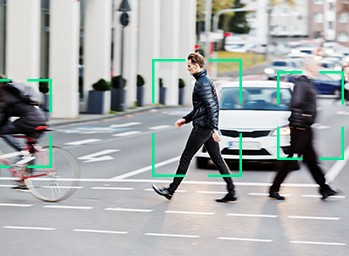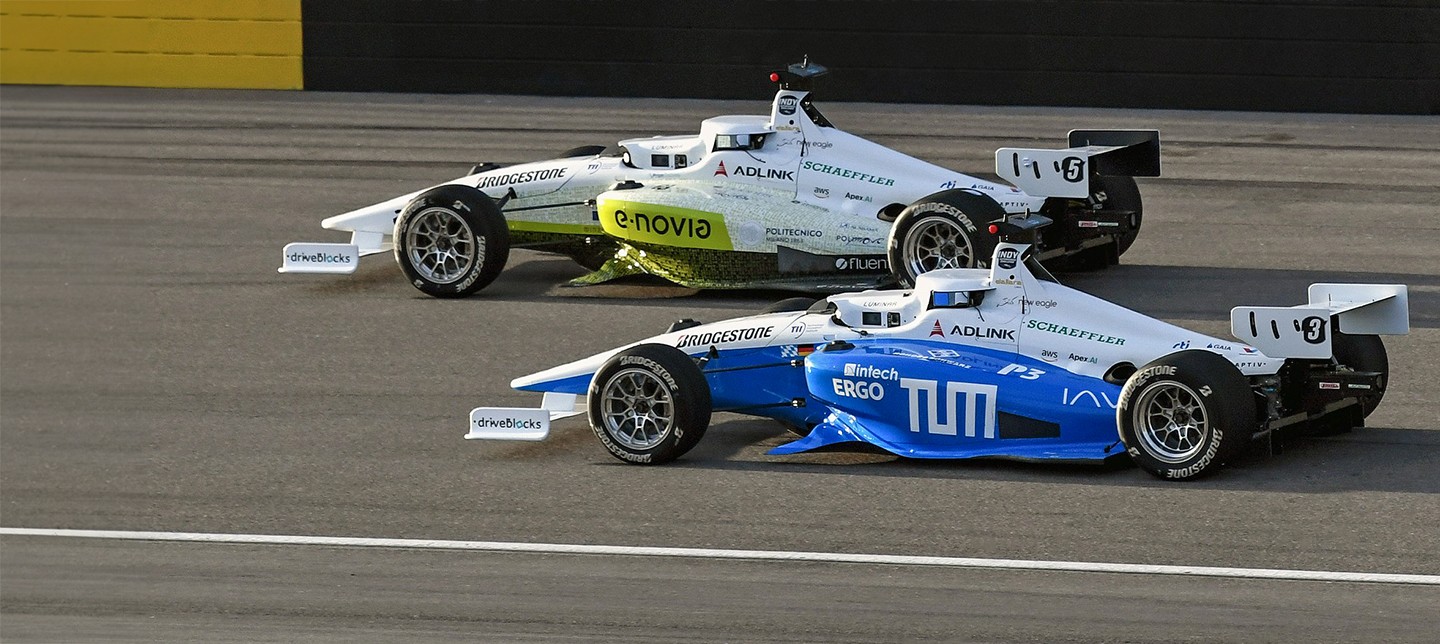
When the Toolchain Becomes as Important as the DUT
Valeo uses NI test solutions from design verification to validation up to manufacturing test, enabling a data- and software-connected ADAS & AD test workflow.

Many technological breakthroughs have been met with skepticism, only to later become widely adopted and profoundly impactful on society. Even the first automobiles were considered noisy, dangerous contraptions that could never replace the horse and carriage.
While it is true that initial automobiles were noisy and dangerous, incredible advancements have improved the comfort and safety of street and highway travel. The automotive industry continues to explore ways to make driving safer, more enjoyable, and effortless. Despite some public skepticism, advanced driver assistance systems (ADAS) and autonomous driving (AD) technologies are moving ahead.
Through fully autonomous racing competitions, the Indy Autonomous Challenge (IAC) provides the stage for university students to push the limits of self-driving technologies and drive public trust. Sponsors, like NI, supply equipment and expertise to enable rapid innovation. Together, these organizations are navigating complex turns at high speeds to improve the reliability and safety of autonomous driving.
Photo Credit: Indy Autonomous Challenge
The previous article in this series explored the value provided by the collaboration between NI and the IAC. Today, we will detail how the IAC is shaping the future of mobility through technology and talent development.
NI’s Member sponsorship of the IAC includes testing hardware and engineering expertise. The expertise and technical support are provided through NI’s Leadership Accelerator Program.
The Leadership Accelerator Program aims to develop customer-focused engineers into leaders whose careers intersect business and technology. This selective two-year program takes new graduate engineers through a series of six-month assignments in four different functional groups at NI. The engineers gain exposure to various aspects of professional careers, through rotations through business functions like marketing or sales, technical, operations, and customer deployment.
The Leadership Accelerator is so much more than I thought it would be. In one year, I’ve gotten the amount of exposure and growth I would have expected in five years.- Joshua Stone, HIL Systems R&D Engineer, Generation NI - XRP
Joshua Stone, the engineer assigned to the first phase of the NI and IAC collaboration, is currently in NI’s Leadership Accelerator Program. His business rotation was in product marketing, and he just finished his technical rotation in the Systems R&D department. He is now moving on to work with site leaders to make process improvements in operations.
When Josh was accepted into the Leadership Accelerator, he knew it was a great opportunity to learn about different aspects of NI’s organization and thought it would help him decide where he wanted to focus his career. He says that the program has exceeded his expectations. Besides developing technical knowledge and soft skills, he’s gained an incredible perspective on how businesses work.
“The Leadership Accelerator is so much more than I thought it would be. In one year, I’ve gotten the amount of exposure and growth I would have expected in five years, ” Stone says.
The IAC chose NI as its exclusive hardware-in-the-loop (HIL) sponsor because of NI’s history as a decades-long industry leader in test automation and HIL testing. As a Member Sponsor, NI provides test engineering expertise and HIL equipment to the IAC teams.
Josh was assigned to work with the IAC as a part of his Systems R&D rotation. His primary objective was to develop a HIL solution for the IAC while providing technical expertise.
Prior to NI’s sponsorship, most IAC teams were limited by software-in-the-loop (SIL) testing. SIL is helpful in early development, but it’s difficult to know how accurate it is because a critical component is missing in SIL simulations – the racecar.
Consider all the potential inputs and variables introduced by the IAC racecar: data provided by the GPS, lidar, radar, cameras, potential equipment malfunctions, vehicle dynamics, and handling.
In contrast, a HIL test solution allows the IAC teams to test various interactions between the driving software and the racecar hardware in conditions closer to the real world. For instance, radar has a specific frequency that is difficult to mimic with SIL, but a HIL system can emulate these frequencies as if it were directly fed from a real radar system. Users can also test variables such as latency, sensor response, and the timing of data connections in real time.
Most IAC teams were not using an open HIL solution, so they couldn’t test these interactions until they reached the racetrack to test with the real racecar. This approach is too late in the game and, because of the potential cost of an accident, prevented teams from really pushing the limits of the car.
The IAC students have computer systems that run their driving algorithms. The students will then connect virtually to the NI ADAS HIL system centrally hosted by the IAC. The HIL hardware includes sensors, motor controllers, and data inputs for equipment specifications. Each team schedules time for conducting their tests on the NI ADAS HIL system.
Essentially, the NI hardware pretends to be the racecar with GPS, cameras, radar, and lidar, enabling students to fine-tune their software and test limits without worrying about crashing the car.
An HIL testing solution pays dividends in reduced test time and costs, but the fact remains: Getting a HIL system to think and act like a racecar requires a lot of expertise, planning, and configuration.
Designing a HIL system requires multidisciplinary expertise, including hardware engineering, software development, and domain-specific knowledge. While there are basic similarities in HIL systems for ADAS and AD applications, each HIL solution is totally unique.
NI ADAS & AD Engineering Center at Austin
By designing an HIL demo, Josh quickly learned enough about NI’s test platform, HIL solution, and autonomous driving (AD) technology to acquire the skills and knowledge necessary for the IAC project. When the demo was presented at the NI Connect conference, Josh discussed NI’s HIL solutions with industry leaders and learned more about potential applications.
Defining scope, exploring test requirements, and eliminating unknowns are critical in any HIL development project. However, the IAC collaboration is unique compared to working with a typical autonomous vehicle (AV) manufacturer, OEM, or integrator.
An AV client would ordinarily have specific objectives for what they want to achieve with a HIL solution. Users in the AV industry have more infrastructure dictating processes and must adhere to strict standards and regulations to protect human lives.
The IAC aims to push limits and break boundaries to advance the technology more quickly. At the same time, NI is eager to explore customizations within these evolving protocols and collaborate on cutting-edge development. This dynamic presents both opportunities and complexities.
The NI and IAC teams agreed to initially focus the current HIL scope on lidar, GPS, and radar. Vehicle dynamics and handling are on the roadmap.
After outlining the customer’s requirements, Josh defined and gathered all the relevant data and specifications for the equipment that must be mimicked in the HIL system. Even with the limited scope of this initial plan, an incredible amount of information was required, such as the placement of sensors relative to each other on the racecar, the performance specifications of each sensor, as well as GPS satellite location data. Moreover, most of the data required comes from a wide variety of sources. For instance, NI must establish relationships with sensor manufacturers to collect proprietary specifications for building an accurate HIL system.
NI ADAS & AD Engineering Center at Austin
Simulation software is also a fundamental component of the HIL system, creating the virtual environment and driving the scenarios. Ansys, a well-established entity in the automotive simulation sector, played a crucial role as a sponsor during the first IAC competition, which primarily focused on the software-in-the-loop (SIL) test. NI chose Ansys based on their expertise on sensor physics and previous experience with the IAC teams. The Ansys AVxcelerate simulation software provides the sensor models used in the official IAC racecar, ensuring ultimate accuracy.
Through HIL testing with accurate specifications and reliable simulation, the safety, efficiency, and reliability of these advanced systems is ensured before they ever hit the racetrack.
Each IAC team competes with its own official racecar, the Dallara AV-21. The uniqueness and performance of each car is based on the software and algorithms developed by the student teams. Think of the software as the driver. Just like human drivers, every algorithm behaves differently in various scenarios: some are careful and risk-averse, others are skilled at handling unexpected situations, and some still struggle with parallel parking.
Photo Credit: Indy Autonomous Challenge
Developing AV software is a continuous process that involves iterative design, testing, and development cycles. HIL testing empowers IAC teams to optimize their software by experimenting with different scenarios, making adjustments, and retesting to verify results.
The IAC teams that leverage NI’s HIL solution have a competitive advantage with their ability to perform a comprehensive range of tests without accessing the physical racecars. NI’s HIL testing solution improves precision, reliability, and safety by revealing how hardware will actually respond to software commands ahead of running on the racetrack.
HIL testing also empowers rapid innovation because IAC teams can continuously deploy software updates and immediately see how their algorithms will play out in real scenarios. The ability to experiment with minimal costs encourages teams to push limits and iterate quickly.
In the engineering equivalent of a relay race, Josh’s successful completion of the first sprint meant it was time to pass the baton to the next engineer in NI’s Leadership Accelerator Program. During his time with NI’s IAC sponsorship, Josh collected requirements, defined a roadmap of the next steps, and made recommendations for how to do it.
As Josh moves on to his third rotation, the next engineer will continue Josh’s work: creating plugins to customize the HIL solution for the IAC, developing training materials for the IAC and the student teams, and providing ongoing support to identify enhancements. Future opportunities include integrating vehicle dynamics into the HIL solution, incorporating NI’s test automation tools, and implementing NI’s data management software.
All this work is not just for a race. The collaboration between the IAC and NI cultivates a rich environment of research and innovation, accelerating AD advancements for safer roadways in the future.